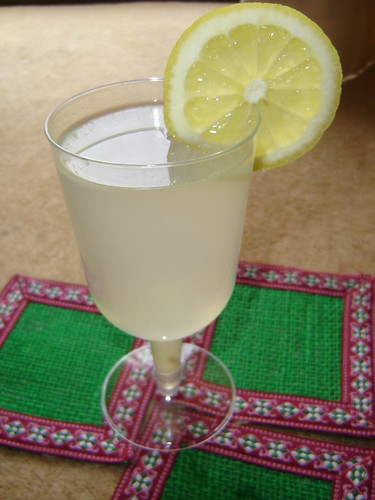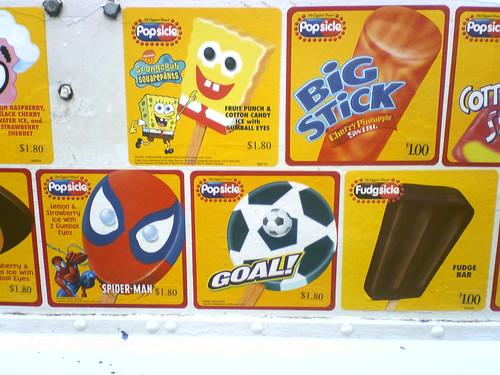


A Brief History Of: Sherbet (not sherbert)
 While ice cream will always melt my heart (get it?), my absolute favorite cold-dessert delight is sherbet.* Specifically, rainbow sherbet, in a sugar cone, topped with rainbow sprinkles. I'm not sure what it is about this that so completely enthralls me, but I can't get enough of it--simple, sweet, colorful, and refreshing. Exactly what I want to eat on a hot summer night, or afternoon, or morning. Or, you know, right now.
While ice cream will always melt my heart (get it?), my absolute favorite cold-dessert delight is sherbet.* Specifically, rainbow sherbet, in a sugar cone, topped with rainbow sprinkles. I'm not sure what it is about this that so completely enthralls me, but I can't get enough of it--simple, sweet, colorful, and refreshing. Exactly what I want to eat on a hot summer night, or afternoon, or morning. Or, you know, right now.When I was a kid, my mom would buy a giant plastic container full of sherbet, which I would steadily work through during the entire summer. A few days ago it dawned on me that I am, technically-speaking, an "adult" with actual purchasing power (hello consumer stimulus!) and that I too could buy myself a huge tub of sherbert (not too much power needed--the whole thing cost about $3.99). And when I say "huge," "giant," I am not kidding: the container is the size of a large dinner plate and about 6 inches deep. It is currently living in my freezer, where it is like a hulking, intimidating Russia surrounded by cowering Hawaiis of Haggen-Das.
 Sherbet is not to be confused with sorbet, at least in my opinion (we'll win over those pesky FDA snobs some day...). The main difference is milk fat content. Both are made with water, sugar, and fruit juice or puree, but sherbet is also mixed with dairy products, having milkfat of less than 3%. While the Food and Drug Administration maintains that sorbet and sherbet are essentially the same things (a tricky distinction for interstate food laws--no joke), if you've ever sat in a restaurant or at an ice cream truck and wondered what was the difference, there you go.
Sherbet is not to be confused with sorbet, at least in my opinion (we'll win over those pesky FDA snobs some day...). The main difference is milk fat content. Both are made with water, sugar, and fruit juice or puree, but sherbet is also mixed with dairy products, having milkfat of less than 3%. While the Food and Drug Administration maintains that sorbet and sherbet are essentially the same things (a tricky distinction for interstate food laws--no joke), if you've ever sat in a restaurant or at an ice cream truck and wondered what was the difference, there you go. The origins of sherbet stretch all the way back to Roman days, when cah-razy emperor Nero decided to serve some delicious cool dessert for a banquet. He had his genial slaves carry buckets of snow from the mountains, then doused the ice in honey and wine (this is the same guy who danced while Rome burned. Foodies are so weird). According to Encarta (and isn't that a blast from the Windows 95 past. Remember "MindMaze"? That game rocked. But I digress...), "sherbet" has origins in an Arabic word, sarbat (also the origin of the word "syrup"), and was originally a popular Middle Eastern drink. It eventually worked its way through Persian and Turkish route before ending up in Europe (English: sherbet, French: sorbet, Italian: sorbetto).
The origins of sherbet stretch all the way back to Roman days, when cah-razy emperor Nero decided to serve some delicious cool dessert for a banquet. He had his genial slaves carry buckets of snow from the mountains, then doused the ice in honey and wine (this is the same guy who danced while Rome burned. Foodies are so weird). According to Encarta (and isn't that a blast from the Windows 95 past. Remember "MindMaze"? That game rocked. But I digress...), "sherbet" has origins in an Arabic word, sarbat (also the origin of the word "syrup"), and was originally a popular Middle Eastern drink. It eventually worked its way through Persian and Turkish route before ending up in Europe (English: sherbet, French: sorbet, Italian: sorbetto).Legend has it that sherbet made the jump from drink to frozen concoction when a glass of the
 stuff was accidentally chilled. In America, ice cream goes back to at least the 1700s, with Dolly Madison introducing the dessert to the White House in 1812. One of the first recorded recipes for sherbet in America dates back to 1905, when Mrs. E.H. Williams submitted her cranberry sherbet recipe to the Los Angeles Times. According to Wikipedia, rainbow sherbet (my fave) was invented by Emanuel Goren in the late 1950's, while he worked at Sealtest Dairies in Philadelphia. Goren developed and popularized the three-nozzle system that gave rainbow sherbet its characteristic marbleized color and flavor.
stuff was accidentally chilled. In America, ice cream goes back to at least the 1700s, with Dolly Madison introducing the dessert to the White House in 1812. One of the first recorded recipes for sherbet in America dates back to 1905, when Mrs. E.H. Williams submitted her cranberry sherbet recipe to the Los Angeles Times. According to Wikipedia, rainbow sherbet (my fave) was invented by Emanuel Goren in the late 1950's, while he worked at Sealtest Dairies in Philadelphia. Goren developed and popularized the three-nozzle system that gave rainbow sherbet its characteristic marbleized color and flavor. Now, sherbet is an American staple, sold in ice cream parlors and hot sidewalks around the country. Its bright colors and creamy texture make it perfect for popsicles or recreating charming children's characters in an alarming fashion.
Now, sherbet is an American staple, sold in ice cream parlors and hot sidewalks around the country. Its bright colors and creamy texture make it perfect for popsicles or recreating charming children's characters in an alarming fashion.*Sherbet is commonly misspelled with an extra "r," as "sherbeRt," possibly because, when translating "sorbet" to English, Americans were more comfortable pronouncing words ending in -bert (Herbert, Robert, Albert...) than -bet (....). This note is not meant to be condescending because I, obviously, also misspelled it until caught by spellcheck. Stupid American English.
No comments:
Post a Comment